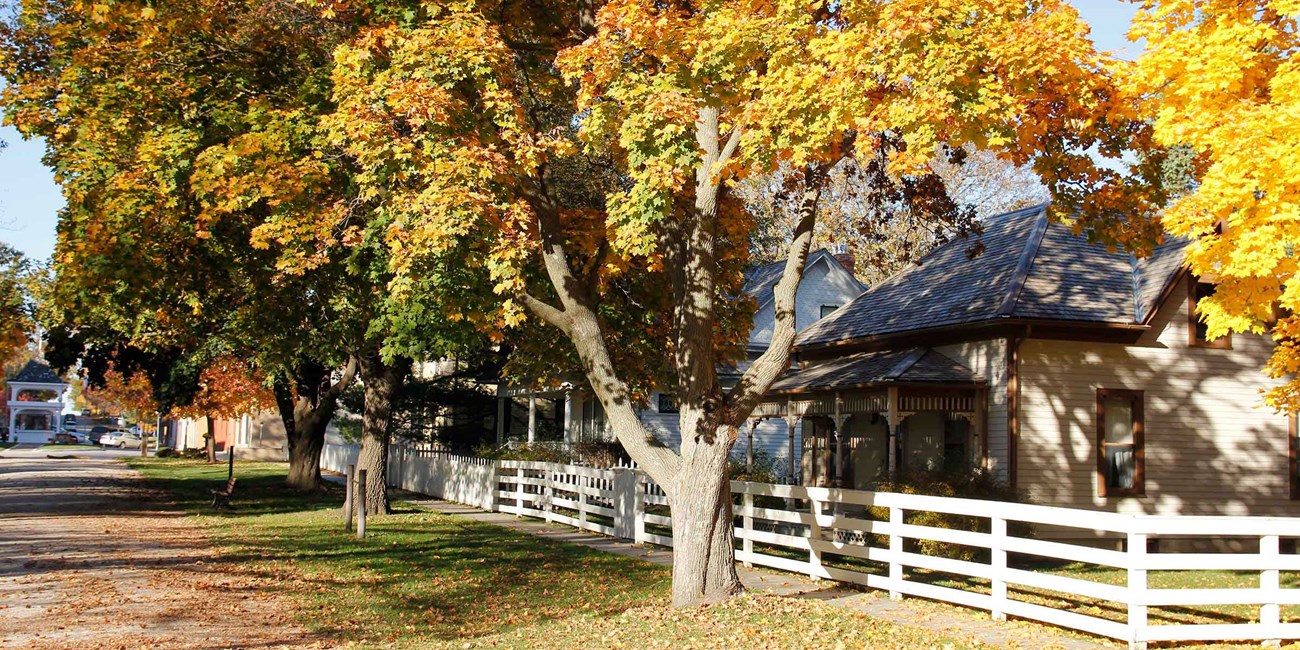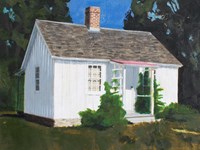Last updated: February 2, 2021
Article
West Branch Grows, 1851-1874

NPS Photo by John Tobiason
West Branch was barely a year-old settlement when Baltimore native Aaron Baker came in 1852. He claimed the free land he had received from the United States government for his service in the Mexican War. Baker promptly sold all 160 acres of it for about a dollar apiece.
By the time John Wetherell purchased five acres in 1869, the price of land had risen considerably. The new real estate developer set about subdividing his property into town lots, and also decided to name a nearby street after himself. The four historic homes on Poplar Street today, the E.S. Hayhurst, Mary Wright, James Staples, and David Mackey houses are the same that stood there when Herbert Hoover was a child.
West Branch boomed between 1869 and 1873. New buildings constructed in the neighborhood near the Hoovers’ small cottage on Downey Street included the Laban Miles House, the Amanda Garvin House, and the Methodist Church, which is no longer standing. When the Burlington, Cedar Rapids & Northern Railroad arrived in West Branch on December 20, 1870, two hundred of the town’s residents celebrated with a picnic dinner.
When Herbert Hoover was born in 1874, West Branch was beginning a long period of growth and general prosperity that lasted through the early part of the 20th century. Commercial downtown buildings from that time remain and are part of the West Branch Commercial Historic District.
Farther up Downey Street to the south were the P.T. Smith and Hannah Varney houses. Those homes, and others, were neighbors to the Hoovers in their second home, the "House of the Maples," which no longer stands.
Later additions to the neighborhood included the L.J. Leech and C.E. Smith houses, both part of the historic site today.
Historic Homes
- Herbert Hoover National Historic Site
L.J. Leech House
- Locations: Herbert Hoover National Historic Site

For thirty-six years Dr. L.J. Leech, a Civil War veteran and graduate of Iowa State University, had lived in the Laban Miles House next door; renting it at first in 1884, and then buying it two years later when the bank foreclosed on the home. By 1920, the well-liked country doctor and Iowa legislator decided to have a new home built for himself.
- Herbert Hoover National Historic Site
Hannah Varney House
- Herbert Hoover National Historic Site
Amanda Garvin House
- Locations: Herbert Hoover National Historic Site

Amanda Garvin was a single 35-year old woman when she bought this property in 1870 for $90.00. She had this cottage built by 1872. The Garvin house is a wonderful example of the Gothic Revival style with its steeply pitched roof, gingerbread bargeboard trim, and ornamental arches framing the open front porch.
- Herbert Hoover National Historic Site
C.E. Smith House
- Locations: Herbert Hoover National Historic Site
- Herbert Hoover National Historic Site
Laban Miles House
- Herbert Hoover National Historic Site
Isaac Miles Farmstead
- Locations: Herbert Hoover National Historic Site
- Herbert Hoover National Historic Site
P.T. Smith House
- Herbert Hoover National Historic Site
Birthplace Cottage
- Locations: Herbert Hoover National Historic Site

In the years following his presidency, Herbert and Lou Hoover restored the president's humble birthplace, which he called, "physical proof of the unbounded opportunity of American life." The small space and few material possessions reflect an ethic of thrift. The cottage was a typical starter home for a young late 19th century family. Antique furnishings represent common household items of a simply furnished two room rural home.
- Herbert Hoover National Historic Site
David Mackey House
- Locations: Herbert Hoover National Historic Site
- Herbert Hoover National Historic Site
Mary Wright House
- Locations: Herbert Hoover National Historic Site

In 1873, J. M. Wetherell sold two lots to Mary Wright. She owned the property for the next 48 years. Her husband, William “Billy” Wright, owned a blacksmith shop at the southwest corner of Main and Poplar streets. Perhaps the competition from neighbor Jesse Hoover, Herbert’s dad, was what led Billy to sell his business in 1875 and open a harness and boot shop.












